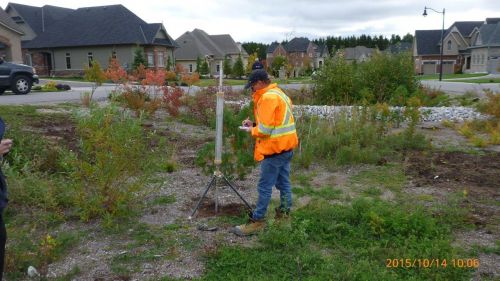Difference between revisions of "Infiltration: Testing"
| Line 1: | Line 1: | ||
| + | [[File:Infiltration_Testing_1.jpeg|500px|thumb|Infiltration testing with a Guelph Permeameter at a site in Glen Williams, Ontario]] | ||
{{TOClimit|2}} | {{TOClimit|2}} | ||
| + | |||
==Four Step Process== | ==Four Step Process== | ||
Soil infiltration testing is a four-step process to obtain the necessary information for stormwater management planning and design. The four steps include: | Soil infiltration testing is a four-step process to obtain the necessary information for stormwater management planning and design. The four steps include: | ||
Latest revision as of 14:22, 20 June 2022
Four Step Process[edit]
Soil infiltration testing is a four-step process to obtain the necessary information for stormwater management planning and design. The four steps include:
1. Background Evaluation
- Based on available published and site specific data;
- Includes consideration of proposed development plan;
- Used to identify potential BMP types, locations and soil test locations;
- Done prior to field work; and
- On-site soil tests may be done to identify/screen potential BMP locations.
2. Test Pit or Soil Boring Observations
- Includes multiple testing locations;
- Provides an understanding of sub-surface conditions; and
- Identifies limiting conditions (e.g., aquitard, bedrock or water table elevations).
- Must be conducted on-site;
- Various testing methods are available; and
- Different testing methods for screening versus verification purposes.
- Determination of a suitable infiltration rate for design calculations; and
- Consideration of desired BMP drainage time.
Test Pit or Soil Boring Observations[edit]
Test pits or soil borings provide information regarding the soil horizons and overall soil conditions both horizontally and vertically in that portion of the site. Multiple observations can be made across a site at a relatively low cost and in a short time period.
Test pit excavations or soil borings should extend to a depth of between 2.5 - 5 m below ground surface or until bedrock or fully saturated conditions are encountered. It is important that the tests provide information related to conditions at least 1.5 m below the proposed bottom elevation of the infiltration BMP. Test pit trenches should be benched at 1 m depth intervals for access and infiltration testing.
At each test location, the following conditions should be noted and described:
- Soil horizons (upper and lower boundary);
- Soil texture and colour for each horizon;
- Color patterns (mottling) and observed depth;
- Depth to water table (if encountered);
- Depth to bedrock (if encountered);
- Observations of pores or roots (size, depth);
- Estimated type and percent coarse fragments;
- Hardpan or other limiting layers; and
- Strike and dip of soil horizons.
External links[edit]
For further information on Borehole observation and test pits please visit the following external links:
- Oak Ridges Moraine Groundwater Management
- Northern Development, Mines, Natural Resources and Forestry's Open Data site for Geotechnical Boreholes
- Northern Development, Mines, Natural Resources and Forestry's Open Data site for Geotechnical Boreholes
- Geological Survey of Canada's Borehole Geophysical Logs
